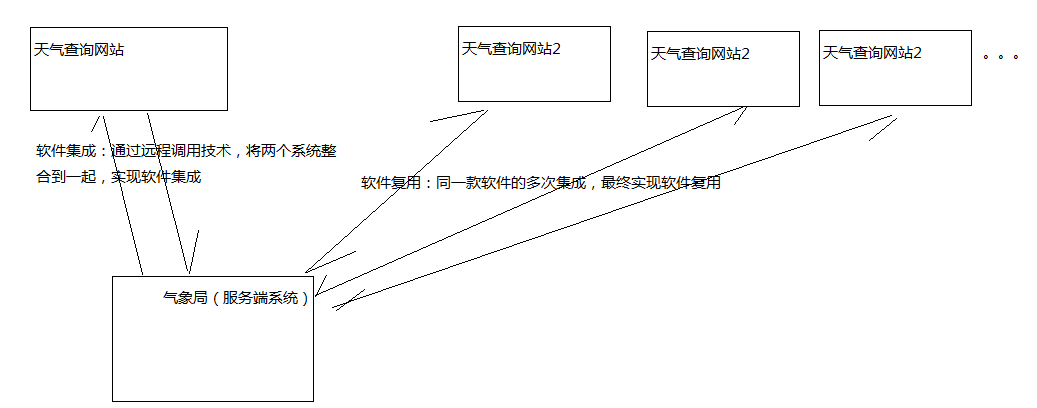WebService是一个SOA(面向服务的编程)的架构,它是不依赖于语言,不依赖于平台,可以实现不同的语言间的相互调用,通过Internet进行基于Http协议的网络应用间的交互。 其实WebService并不是什么神秘的东西,它就是一个可以远程调用的类,或者说是组件,把你本地的功能开放出去共别人调用。具体的说,Web Service可以让你的网站使用其他网站的资源,比如在网页上显示天气、地图、twitter上的最新动态等等。
一、为什么用WebService
比如你的项目需要查询某银行账户余额。你能直接查吗,肯定不行,因为数据库是银行的,他不可能给你权限。你想访问他的数据库获取数据,这就需要用到WebService。通过调用银行暴露的接口来得到你想要的数据。
1. 适用场景
软件的集成和复用,如气象局(服务端系统)、天气查询网站等。
- 发布一个服务(对内/对外),不考虑客户端类型,不考虑性能,建议WebService
- 服务端已经确定使用webservice,客户端不能选择,必须使用WebService
软件集成即通过远程调用技术,将两个系统整合到一起,从而实现软件集成。
软件复用即同一个款软件的多次集成,最终实现复用。

2. 不适用场景
- 考虑性能时不建议使用WebService:采用xml格式封装数据,所以在传输过程中,要传输额外的标签,随着soap协议的不断完善,标签越来越大,导致webservice的性能下降。
- 同构程序下不建议使用webservice,比如java 用RMI,不需要翻译成XML的数据。
二、WebService的原理
在Web Service的体系架构中有三个角色:服务提供者(Service Provider),也叫服务生产者;服务请求者(Service Requester),也叫服务消费者;服务注册中心(Service Register),也叫服务代理,服务提供者在这里发布服务,服务请求者在这里查找服务,获取服务的绑定信息。

角色间主要有三个操作:
- 发布(Publish),服务提供者把服务按照规范格式发布到服务注册中心;
- 查找(Find),服务请求者根据服务注册中心提供的规范接口发出查找请求,获取绑定服务所需的相关信息。
- 绑定(Bind),服务请求者根据服务绑定信息对自己的系统进行配置,从而可以调用服务提供者提供的服务。
Web Service的实现是通过SOAP在Web上提供的软件服务,使用WSDL文件进行说明,并通过UDDI进行注册。
相关概念:
- XML:(Extensible Markup Language)扩展型可标记语言。面向短期的临时数据处理、面向万维网络,是SOAP的基础。
- SOAP:(Simple Object Access Protocol)简单对象存取协议。是XML Web Service 的通信协议。当用户通过UDDI找到你的WSDL描述文档后,他通过可以SOAP调用你建立的Web服务中的一个或多个操作。SOAP是XML文档形式的调用方法的规范,它可以支持不同的底层接口,像HTTP(S)或者SMTP。
- WSDL:(Web Services Description Language) WSDL 文件是一个 XML 文档,用于说明一组 SOAP 消息以及如何交换这些消息。大多数情况下由软件自动生成和使用。
- UDDI (Universal Description, Discovery, and Integration) 是一个主要针对Web服务供应商和使用者的新项目。在用户能够调用Web服务之前,必须确定这个服务内包含哪些商务方法,找到被调用的接口定义,还要在服务端来编制软件,UDDI是一种根据描述文档来引导系统查找相应服务的机制。UDDI利用SOAP消息机制(标准的XML/HTTP)来发布,编辑,浏览以及查找注册信息。它采用XML格式来封装各种不同类型的数据,并且发送到注册中心或者由注册中心来返回需要的数据。
三、Axis2与CXF的区别
目前java开发WebService的框架主要包括Axis2和CXF,如果你需要多语言的支持,你应该选择Axis2。如果你需要把你的实现侧重java并希望和Spring集成,CXF就是更好的选择,特别是把你的WebService嵌入其他的程序中。

四、SpringBoot使用CXF集成WebService
1. 服务端构建
(1) 引入依赖
<!-- 核心启动器 --> <dependency> <groupId>org.springframework.boot</groupId> <artifactId>spring-boot-starter</artifactId> </dependency> <!-- web启动器 --> <dependency> <groupId>org.springframework.boot</groupId> <artifactId>spring-boot-starter-web</artifactId> </dependency> <!-- webService--> <dependency> <groupId>org.springframework.boot</groupId> <artifactId>spring-boot-starter-web-services</artifactId> </dependency> <!-- CXF webservice --> <dependency> <groupId>org.apache.cxf</groupId> <artifactId>cxf-spring-boot-starter-jaxws</artifactId> <version>3.2.1</version> </dependency> <dependency> <groupId>org.apache.cxf</groupId> <artifactId>cxf-rt-transports-http</artifactId> <version>3.2.1</version> </dependency> <!-- CXF webservice -->
(2) 接口
@WebService(name = "ServerServiceDemo", targetNamespace = "http://server.webservice.example.com") public interface ServerServiceDemo { @WebMethod String emrService(@WebParam String data); }
(3) 接口实现类
/** * WebService涉及到的有这些 "四解三类 ", 即四个注解,三个类 * @WebMethod * @WebService * @WebResult * @WebParam * SpringBus * Endpoint * EndpointImpl * * 一般我们都会写一个接口,然后再写一个实现接口的实现类,但是这不是强制性的 * @WebService 注解表明是一个webservice服务。 * name:对外发布的服务名, 对应于<wsdl:portType name="ServerServiceDemo"></wsdl:portType> * targetNamespace:命名空间,一般是接口的包名倒序, 实现类与接口类的这个配置一定要一致这种错误 * Exception in thread "main" org.apache.cxf.common.i18n.UncheckedException: No operation was found with the name xxxx * 对应于targetNamespace="http://server.webservice.example.com" * endpointInterface:服务接口全路径(如果是没有接口,直接写实现类的,该属性不用配置), 指定做SEI(Service EndPoint Interface)服务端点接口 * serviceName:对应于<wsdl:service name="ServerServiceDemoImplService"></wsdl:service> * portName:对应于<wsdl:port binding="tns:ServerServiceDemoImplServiceSoapBinding" name="ServerServiceDemoPort"></wsdl:port> * * @WebMethod 表示暴露的服务方法, 这里有接口ServerServiceDemo存在,在接口方法已加上@WebMethod, 所以在实现类中不用再加上,否则就要加上 * operationName: 接口的方法名 * action: 没发现又什么用处 * exclude: 默认是false, 用于阻止将某一继承方法公开为web服务 * * @WebResult 表示方法的返回值 * name:返回值的名称 * partName: * targetNamespace: * header: 默认是false, 是否将参数放到头信息中,用于保护参数,默认在body中 * * @WebParam * name:接口的参数 * partName: * targetNamespace: * header: 默认是false, 是否将参数放到头信息中,用于保护参数,默认在body中 * model:WebParam.Mode.IN/OUT/INOUT */ @Component @WebService(name = "ServerServiceDemo", targetNamespace = "http://server.webservice.example.com", endpointInterface = "com.example.webservice.service.ServerServiceDemo") public class ServerServiceDemoImpl implements ServerServiceDemo{ @Override public String emrService(@WebParam String data) { if(null == data || "".equals(data.trim())){ return "传入的参数为空"; } return "调用成功"; } }
(4) 接口发布类
/** * 注意: * org.apache.cxf.Bus * org.apache.cxf.bus.spring.SpringBus * org.apache.cxf.jaxws.EndpointImpl * javax.xml.ws.Endpoint */ @Configuration public class WebServiceConfig { @Autowired private ServerServiceDemo serverServiceDemo; /** * Apache CXF 核心架构是以BUS为核心,整合其他组件。 * Bus是CXF的主干, 为共享资源提供一个可配置的场所,作用类似于Spring的ApplicationContext,这些共享资源包括 * WSDl管理器、绑定工厂等。通过对BUS进行扩展,可以方便地容纳自己的资源,或者替换现有的资源。默认Bus实现基于Spring架构, * 通过依赖注入,在运行时将组件串联起来。BusFactory负责Bus的创建。默认的BusFactory是SpringBusFactory,对应于默认 * 的Bus实现。在构造过程中,SpringBusFactory会搜索META-INF/cxf(包含在 CXF 的jar中)下的所有bean配置文件。 * 根据这些配置文件构建一个ApplicationContext。开发者也可以提供自己的配置文件来定制Bus。 */ @Bean(name = Bus.DEFAULT_BUS_ID) public SpringBus springBus() { return new SpringBus(); } /** * 此方法作用是改变项目中服务名的前缀名,此处127.0.0.1或者localhost不能访问时,请使用ipconfig查看本机ip来访问 * 此方法被注释后, 即不改变前缀名(默认是services), wsdl访问地址为 http://127.0.0.1:8080/services/ws/api?wsdl * 去掉注释后wsdl访问地址为:http://127.0.0.1:8080/soap/ws/api?wsdl * http://127.0.0.1:8080/soap/列出服务列表 或 http://127.0.0.1:8080/soap/ws/api?wsdl 查看实际的服务 * 新建Servlet记得需要在启动类添加注解:@ServletComponentScan * * 如果启动时出现错误:not loaded because DispatcherServlet Registration found non dispatcher servlet dispatcherServlet * 可能是springboot与cfx版本不兼容。 * 同时在spring boot2.0.6之后的版本与xcf集成,不需要在定义以下方法,直接在application.properties配置文件中添加: * cxf.path=/service(默认是services) */ //@Bean //public ServletRegistrationBean dispatcherServlet() { // return new ServletRegistrationBean(new CXFServlet(), "/soap/*"); //} @Bean public Endpoint endpoint() { EndpointImpl endpoint = new EndpointImpl(springBus(), serverServiceDemo); endpoint.publish("/ws/api"); return endpoint; } }
(5) 启动项目
访问地址:http://localhost:8080/services/ 列出在services下的所有服务列表

http://localhost:8080/services/ws/api?wsdl 查看访问具体的服务信息。

标签的重要信息说明可以参考:https://blog.csdn.net/xxssyyyyssxx/article/details/50292787
3. 客户端构建
创建一个新的项目。
(1) 引入依赖
<!-- 核心启动器 --> <dependency> <groupId>org.springframework.boot</groupId> <artifactId>spring-boot-starter</artifactId> </dependency> <!-- webService--> <dependency> <groupId>org.springframework.boot</groupId> <artifactId>spring-boot-starter-web-services</artifactId> </dependency> <!-- CXF webservice --> <dependency> <groupId>org.apache.cxf</groupId> <artifactId>cxf-spring-boot-starter-jaxws</artifactId> <version>3.2.1</version> </dependency> <dependency> <groupId>org.apache.cxf</groupId> <artifactId>cxf-rt-transports-http</artifactId> <version>3.2.1</version> </dependency> <!-- CXF webservice --> <!-- 如果使用代理类工厂的方式, 因需要知道服务端发布的接口名,所以这里是需要引入服务端的接口模块。 服务端一般需要将所有对外接口抽取到单独的一个模块,再再pom.xml进行引入 -->
(2) 调用代码
/** * 1.代理类工厂的方式,需要拿到对方的接口地址, 同时需要引入接口 */ // public static void invokeService_1(){ // // 接口地址 // String address = "http://localhost:8080/services/ws/api?wsdl"; // // 代理工厂 // JaxWsProxyFactoryBean jaxWsProxyFactoryBean = new JaxWsProxyFactoryBean(); // // 设置代理地址 // jaxWsProxyFactoryBean.setAddress(address); // // 设置接口类型 // jaxWsProxyFactoryBean.setServiceClass(ServerServiceDemo.class); // // 创建一个代理接口实现 // ServerServiceDemo us = (ServerServiceDemo) jaxWsProxyFactoryBean.create(); // // 数据准备 // String data = "hello world"; // // 调用代理接口的方法调用并返回结果 // String result = us.emrService(data); // System.out.println("返回结果:" + result); // } /** * 2. 动态调用 */ public static void invokeService_2(){ // 创建动态客户端 JaxWsDynamicClientFactory dcf = JaxWsDynamicClientFactory.newInstance(); Client client = dcf.createClient("http://localhost:8080/services/ws/api?wsdl"); // 需要密码的情况需要加上用户名和密码 // client.getOutInterceptors().add(new ClientLoginInterceptor(USER_NAME, PASS_WORD)); Object[] objects = new Object[0]; try { // invoke("方法名",参数1,参数2,参数3....); //这里注意如果是复杂参数的话,要保证复杂参数可以序列化 objects = client.invoke("emrService", "hello world"); System.out.println("返回数据:" + objects[0]); } catch (java.lang.Exception e) { e.printStackTrace(); } }
参考:
https://blog.csdn.net/sujin_/article/details/83865124